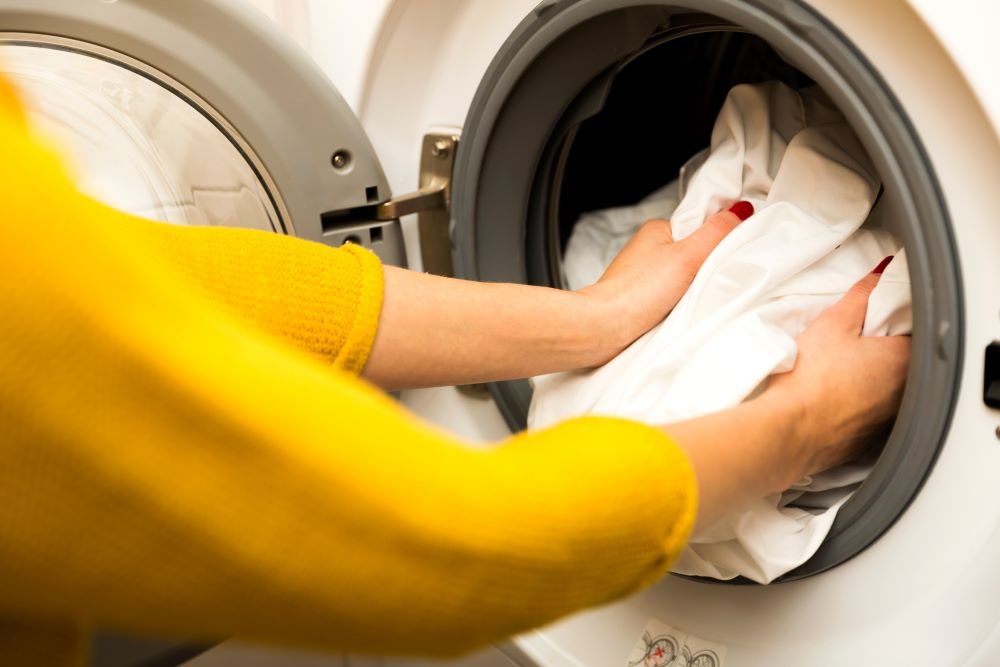Washer dryers are a great way to save space and cut down on the time it takes you to move each load between machines. In this guide we’ve found the UK’s best integrated washer dryers, so not only do you get the convenience of two machines in one but you can close the door and have it blend seamlessly with your kitchen cupboards.
As with many types of washing machine, integrated washer dryers come in different types and have a multitude of features. We’ve created this list so you can explore the strengths and weaknesses of each model before making a purchase.
In a hurry? Check out the HOOVER H-WASH 300 Pro HBDOS695TAMCET – our number one integrated washer dryer in the UK. You can jump to this section by clicking its entry in the table of contents below.
What is an integrated washer dryer?
Integrated washer dryers combine a front loading washing machine and a tumble dryer into a single unit. They are meant to fit snugly into your fitted kitchen to ensure it maintains its streamlined look. Their flat front design means you can attach your kitchen cupboard door to the machine so that it operates behind the scenes.
Integrated washer dryer machines tend to be quieter than their standalone equivalents as they work behind kitchen cupboard doors that muffle most of the noises and vibrations. They are generally small-sized as they have to fit into fixed spaces. The most significant consequence of this is that most models can only hold small loads that don’t often exceed 8kg of wash and 5kg of dry clothes.
Integrated washer dryers are available in two main types; fully integrated and semi-integrated. The fully integrated type will be completely concealed behind the cupboard door. Semi-integrated models have most of their body hidden. However, the space along the top will be visible to allow you to monitor what’s happening on the display panel.
Some integrated machines cost more than their freestanding counterparts and can consume more water and power than most standalone washers. This makes it particularly important that you do your research and choose your machine carefully. Every model in this list has been selected following our rigorous selection criteria, which includes value for money and efficiency.
Will I have less choice by going integrated?
Yes. All integrated machines, not just the washer-dryers, are almost always fewer in number and can come with reduced functionalities than their conventional equivalents.
In the case of washer-dryer combos, there’s a noticeable difference in the available varieties of these machines compared to the freestanding models. In terms of functionalities, the biggest compromise you’ll be making once you decide to go integrated is load capacity. During our extensive market search, the best we found hold a maximum of 8kg wash load. Most models have a 7kg capacity which is 4-5kg less than most standard freestanding machines hold.
So, if you do a lot of washing or have a large family, integrated washer-dryer combos might not be suitable for you. But if you live in a smaller household, or don’t have access to other drying options, these machines are well worth the extra investment.
Why choose an integrated washer dryer?
When it comes to placing your integrated washer dryer, its a lot easier than most standard tumble dryers. You will need electricity and water, but there is no need for the usual dryer outlet. This is because any water vapour produced by the wet clothes is condensed and added to the washing machines outlet pipe. So, as long as you have standard washing machine plumbing, you’re ready to go.
Below is a summary of the pros and cons of using integrated washer dryers:
Pros
- They’re easy to use and take clothes from dirty to clean and dry in one cycle
- Low noise and vibrations compared to freestanding models
- They will blend in with your existing kitchen cupboards
- There is no need for a tumble dryer outlet pipe
- They take up one space instead of two.
Cons
- Some are pricier than freestanding equivalents
- Suited for smaller loads, so they aren’t ideal for larger families
What should I look for when buying an integrated washer dryer?
The number of integrated washer dryer combos in the market might not be big compared to their freestanding counterparts. Still, selecting the right machine that suits your needs and preferences can be a daunting task.
To help you find the right machine consider the following features:
Load capacity
The load capacity is the maximum weight of washing the drum can accommodate at one time. With washer dryers, there are two types of load to consider: the washing capacity and the drying capacity.
Washing capacity for standard integrated washer dryers ranges from 5-8kg. The higher the capacity, the more clothes you can wash in one go and the more time, energy and water savings you will enjoy.
The drying load capacity is always lower than the washing load capacity and often range from 2.5-5kg. The reason behind this is drying requires additional space in the drum for air to circulate, unlike washing where clothes can be packed in tightly. A machine with more drying capacity offers extra space for spinning. This helps to reduce the time and energy required to dry your laundry.
Energy and water efficiency
Water and energy consumption is an essential consideration when buying an integrated washer dryer. The model you choose should be able to use as little of these resources as possible.
All washer dryers must come with an EU label that displays their energy rating. Ratings range from A to G, with A being the most energy-efficient and G the worst. In practice though, it’s near-impossible to find a model with a rating lower than C. We recommend going for machines with the highest possible energy efficiency, as this translates to less energy consumption and consequently reduced utility bills and carbon print.
Most machines now come with a label indicating the litres of water consumed per kilogram of washing. A water efficiency of approximately 35 litres per 3.5kg is at a good standard. We have seen some that consume up to 70 litres for the same load, so it’s always worth checking.
Now, numerous additional features have been designed to can help you save on energy and water. They include quick wash functions and weight detection technology. Weight detection technology will weigh each load and apply a unique program that gets them both clean and dry, with precisely the exact amount of power and water required. There are also washer dryers available that use sensors to detect when the clothes are dry and then turn the machine off.
Spin speed
The number of times your washer dryer spins per minute are referred to as the spin speed. Most integrated washer dryers have spin speed ranges of 1200-1600rpm. We recommend going for machines with higher spin speeds as they’re able to remove most of the water during the washing phase. As a result, they reduce the time it takes to dry clothes, thus saving more energy and money.
Special features
Different integrated washer dryers pack various additional (and often intelligent) features that influence their overall performance. A few useful functions you might want to consider are:
- Steam function – a forward-looking option that helps you get rid of stubborn stains while maintaining your fabric’s texture and reducing creases.
- Sensitivity feature – this one is ideal for people who are sensitive to dust and pollen.
- Child lock – helps to minimize dangers by ensuring your little ones can’t switch on the programmes when you’re not around.
Best integrated washer-dryers in the UK
These are our picks of top four integrated washer dryers available in the UK, based on factors such as price, energy and water efficiency, programmes, drum size and dimensions:
No 1: HOOVER H-WASH 300 Pro HBDOS695TAMCET
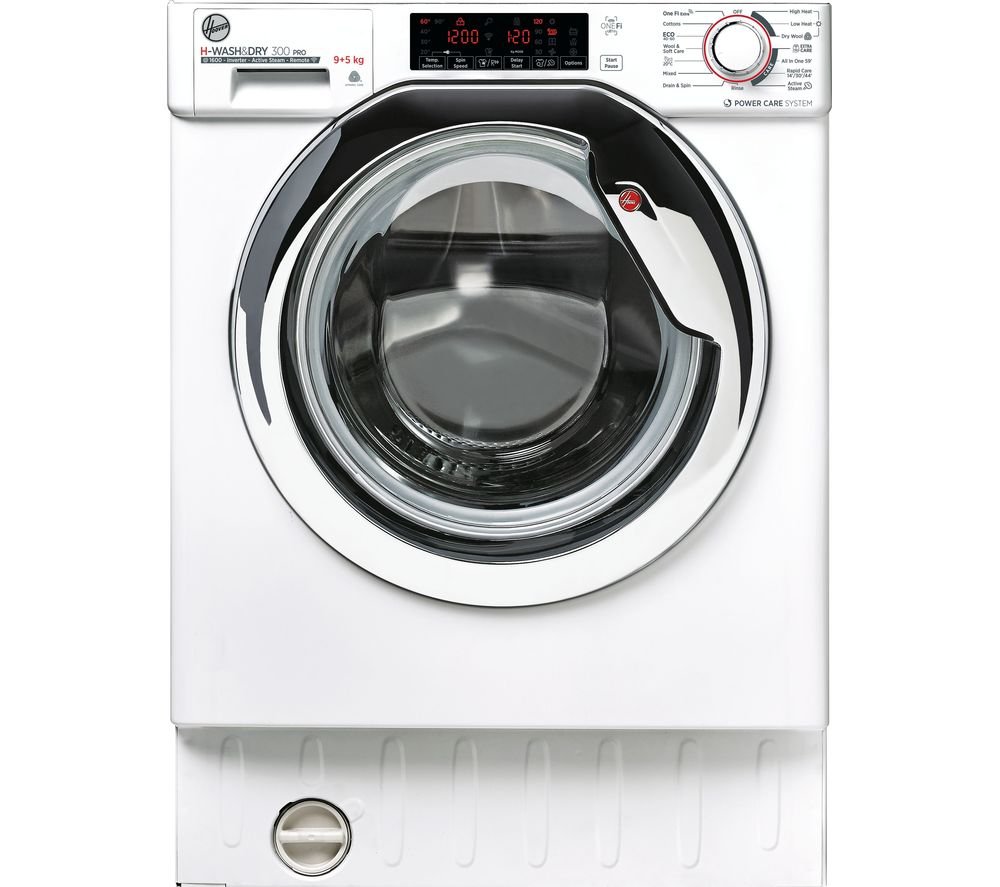
HOOVER HBDOS695TAMCET specification |
|
| Price (£) | 499 |
| Energy rating | D |
| Water usage (litres) | 26000 |
| Spin speed (rpm) | 1600 |
| Wash capacity/Drying capacity (kg) | 9/5 |
| Special programmes | Active Steam, All in One 59 |
| Dimensions (cm) | H82 x W60 x D53 |
The H-Wash 300 Pro HBDOS695TAMCET from Hoover is an integrated washer-dryer with a spin speed of 1600 rpm, a washing capacity of 9kg and a drying capacity of 5kg. The extra power needed for the dryer means that the energy rating of D isn’t as high as it could be but in every other aspect, it offers incredible value.
Whether you’re in a hurry or just don’t want to spend time sorting your clothes, you’ll find the program setting for you. The quick wash can process up to 1.5kg of laundry in 14 minutes and the all in one 59 minute program can take clothes of any colour mixed together. It also features the excellent ‘KG mode’, which uses internal sensors to weigh the clothes and set the most efficient program. You can also set your desired level of dryness and the dryer will switch off automatically once it’s reached.
If you want to get advanced with the settings or make changes from the next room, the H-Wash 300 Pro can be connected to WiFi and Bluetooth. You can control it via a phone app or any smart device that is compatible with Alexa or Google Home. With all these mod cons and the powerful yet efficient motor, you aren’t going to find better when it comes to integrated washer-dryers.
No 2: Zanussi Z716WT83Bl
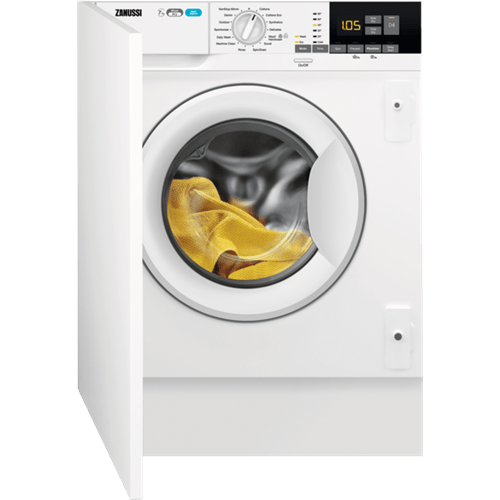
Zanussi Z716WT83BI specification |
|
| Price (£) | 599 |
| Energy rating | E |
| Water usage (litres) | 23000 |
| Spin speed (rpm) | 1600 |
| Wash capacity/Drying capacity (kg) | 8/4 |
| Special programmes | DuoSensor, AutoAdjust Load Sensor, NonStop 60-Minute Programme |
| Dimensions (cm) | H81.9 x W59.6 x D54.0 |
When I first came across the Zanussi Z716WT83BI integrated washer dryer, the thing that caught my attention was its inventive AutoAdjust function. The machine uses this feature to weigh any load put inside its drum automatically. With this information, it’s able to determine how much water, energy and time is needed to complete a cycle. The result is increased efficiency while maintaining stellar wash results.
This model also comes with 21 wash and dry programmes – the most of any washer dryer we’ve reviewed here. Its Hand Wash function will prove handy if you clean delicate clothes often. It helps to maintain their texture and appearance by cleaning them with a more gentle cycle. Another feature worth a mention is its nonstop 60-Minute programme that allows you to wash and dry your clothes in 60 minutes.
If you thought the innovation of Zanussi ends there, you’re wrong! They also pack in a feature known as DuoSensor. Like the AutoAdjust function, DuoSensor is pretty intelligent and helps to identify the type of fabric introduced in the washer dryer. It then adjusts drum movements and temperature, making sure your fabrics are cleaned at the ideal setting.
The Z716WT83BI model has a 8kg wash capacity and 4kg drying capacity, which makes it ideal for medium and some large-sized households. It measures H81.9 x W59.6 x D54cm and is only available in white.
No 3: AEG L7WE7631Bl
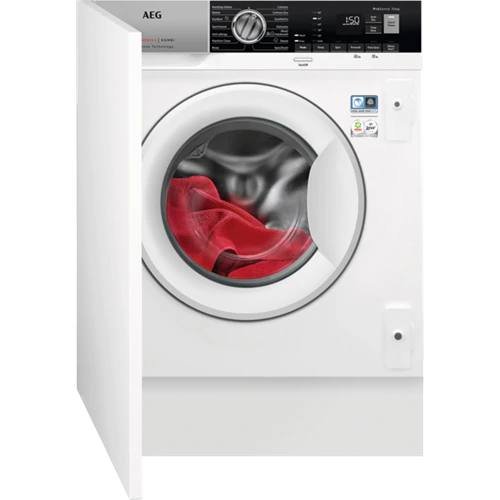
AEG L7WE7631BI specification |
|
| Price (£) | 699 |
| Energy rating | A |
| Water usage (litres) | 19000 |
| Spin speed (rpm) | 1550 |
| Wash capacity/Drying capacity (kg) | 7/4 |
| Special programmes | NonStop 60-Minute Programme, ProSense Technology, DualSense |
| Dimensions (cm) | H81.9 x W59.6 x D54.0 |
The L7WE7631BI 7000 Series is another powerful washer dryer that cleans your clothes with absolute convenience without compromising on care. We were impressed to see the numerous attractive features it packs in, including its proprietary ProSense Technology, 1600 rpm spin speed and the NonStop 60-minute programme.
One thing we can all agree about this model is that AEG invested heavily in its technology. The first on its long list of advanced features is the DualSense Technology. This function enables the washer-dryer to detect fabric types automatically, after which it adjusts its temperature and drum movements. As a result, your fabrics retain their shape and size. Another equally useful function is the ProSense Technology which this machine uses to detect load size and automatically adjust washing times as well as water and energy requirements.
If you’re In a hurry and have a specific outfit, you’d like to wear for the day? Use L7WE7631BI’s NonStop 60-minute Programme to wash and wear it in one hour.
Apart from the tech features, the L7WE7631BI 7000 Series Integrated Washer Dryer also provides several other functions like the Steam Programme and Sensitive feature. The latter allows you to refresh your clothing without going through a full cycle. The setting introduces steam into the drum and removes creases while also relaxing the fibres.
AEG’s L7WE7631BI 7000 Series model weighs 74kg and measures 81.9 x 59.6 x 54cm.
Best Budget: LOGIK LI8W6D20
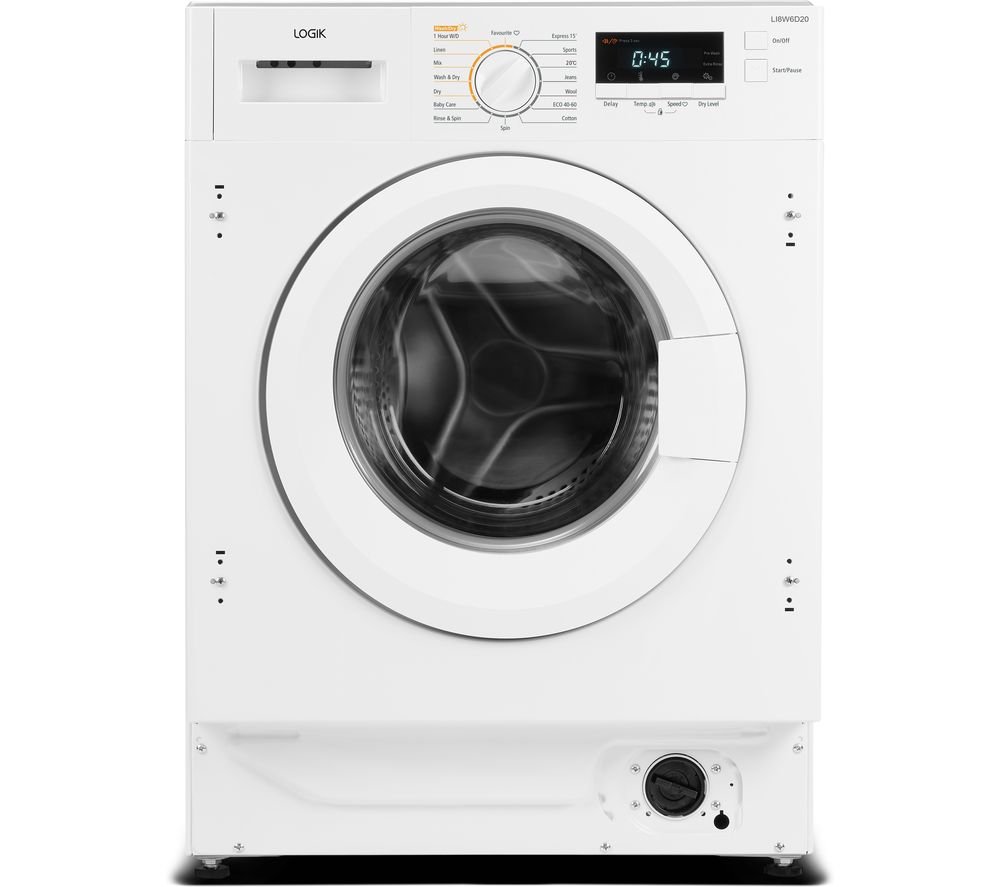
LOGIK LI8W6D20 model details |
|
| Price (£) | 369 |
| Energy rating | E |
| Water usage (litres) | 27200 |
| Spin speed (rpm) | 1400 |
| Wash capacity/Drying capacity (kg) | 8/6 |
| Special programmes | 1 Hour W/D, Baby care, Express 15, Sports, Wash & dry |
| Dimensions (cm) | H82 x W60 x D55 |
You don’t have to break the bank to own a washer-dryer. Logik’s LI8W6D20 is a powerful integrated model with a large drum and several useful preset programmes. The only drawback is the E energy rating, but as you can see with the other items on this list, it’s rare to find a washer-dryer with a B or A rating. The addition of the dryer tends to drive up the power usage; for example, with the dryer, the combined consumption is 1088 kWh, whereas with the washer only, it would be 150kWh.
With its 8kg wash and 6kg dry capacity, this is an ideal size for most families, from three to eight people. The LI8W6D20 also incorporates multiple useful programmes to help you save both time and energy. It only has one drying programme, but there are three settings to ensure you get the results you’re looking for.
Theres also a helpful delay timer that can be set to wait for up to 24 hours. The main controls are simple to set and easy to read. The L18W6D20 model measures 82 x 60 x 55cm, while Logik gives you a 1-year warranty on the machine’s motor.
Conclusion
Choosing the best integrated washer dryer doesn’t have to be a daunting task, at least not after you’ve read our detailed guide. Before choosing a suitable machine from the five we’ve reviewed here, start by identifying your laundry needs and the maximum budget available. After that, weigh the pros and cons of each model and pick one that befits your household.


